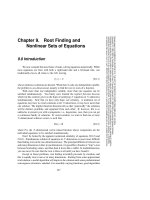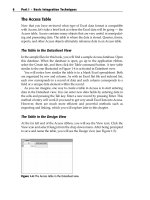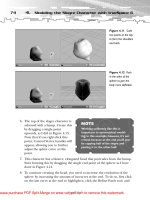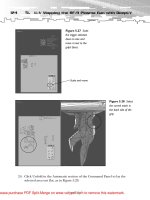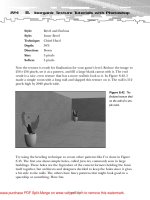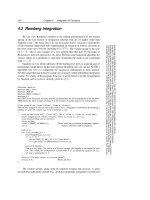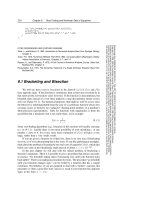Tài liệu Root Finding and Nonlinear Sets of Equations part 4 doc
Bạn đang xem bản rút gọn của tài liệu. Xem và tải ngay bản đầy đủ của tài liệu tại đây (86.55 KB, 4 trang )
9.3 Van Wijngaarden–Dekker–BrentMethod
359
Sample page from NUMERICAL RECIPES IN C: THE ART OF SCIENTIFIC COMPUTING (ISBN 0-521-43108-5)
Copyright (C) 1988-1992 by Cambridge University Press.Programs Copyright (C) 1988-1992 by Numerical Recipes Software.
Permission is granted for internet users to make one paper copy for their own personal use. Further reproduction, or any copying of machine-
readable files (including this one) to any servercomputer, is strictly prohibited. To order Numerical Recipes books,diskettes, or CDROMs
visit website or call 1-800-872-7423 (North America only),or send email to (outside North America).
for (j=1;j<=MAXIT;j++) {
xm=0.5*(xl+xh);
fm=(*func)(xm); First of two function evaluations per it-
eration.s=sqrt(fm*fm-fl*fh);
if (s == 0.0) return ans;
xnew=xm+(xm-xl)*((fl >= fh ? 1.0 : -1.0)*fm/s); Updating formula.
if (fabs(xnew-ans) <= xacc) return ans;
ans=xnew;
fnew=(*func)(ans); Second of two function evaluations per
iteration.if (fnew == 0.0) return ans;
if (SIGN(fm,fnew) != fm) { Bookkeeping to keep the root bracketed
on next iteration.xl=xm;
fl=fm;
xh=ans;
fh=fnew;
} else if (SIGN(fl,fnew) != fl) {
xh=ans;
fh=fnew;
} else if (SIGN(fh,fnew) != fh) {
xl=ans;
fl=fnew;
} else nrerror("never get here.");
if (fabs(xh-xl) <= xacc) return ans;
}
nrerror("zriddr exceed maximum iterations");
}
else {
if (fl == 0.0) return x1;
if (fh == 0.0) return x2;
nrerror("root must be bracketed in zriddr.");
}
return 0.0; Never get here.
}
CITED REFERENCES AND FURTHER READING:
Ralston, A., and Rabinowitz, P. 1978,
A First Course in Numerical Analysis
, 2nd ed. (New York:
McGraw-Hill),
§
8.3.
Ostrowski, A.M. 1966,
Solutions of Equations and Systems of Equations
, 2nd ed. (New York:
Academic Press), Chapter 12.
Ridders, C.J.F. 1979,
IEEE Transactions on Circuits and Systems
, vol. CAS-26, pp. 979–980. [1]
9.3 Van Wijngaarden–Dekker–Brent Method
While secant and false position formally converge faster than bisection, one
finds in practice pathological functions for which bisection converges more rapidly.
These can be choppy, discontinuousfunctions,or even smoothfunctionsif thesecond
derivative changes sharply near the root. Bisection always halves the interval, while
secant and false position can sometimes spend many cycles slowly pulling distant
bounds closer to a root. Ridders’ method does a much better job, but it too can
sometimes be fooled. Is there a way to combine superlinear convergence with the
sureness of bisection?
360
Chapter 9. Root Finding and Nonlinear Sets of Equations
Sample page from NUMERICAL RECIPES IN C: THE ART OF SCIENTIFIC COMPUTING (ISBN 0-521-43108-5)
Copyright (C) 1988-1992 by Cambridge University Press.Programs Copyright (C) 1988-1992 by Numerical Recipes Software.
Permission is granted for internet users to make one paper copy for their own personal use. Further reproduction, or any copying of machine-
readable files (including this one) to any servercomputer, is strictly prohibited. To order Numerical Recipes books,diskettes, or CDROMs
visit website or call 1-800-872-7423 (North America only),or send email to (outside North America).
Yes. We can keep track of whether a supposedly superlinear method is actually
converging the way it is supposed to, and, if it is not, we can intersperse bisection
steps so as to guarantee at least linear convergence. This kind of super-strategy
requires attention to bookkeeping detail, and also careful consideration of how
roundoff errors can affect the guiding strategy. Also, we must be able to determine
reliably when convergence has been achieved.
An excellent algorithm that pays close attention to these matters was developed
in the 1960s by van Wijngaarden, Dekker, and others at the Mathematical Center
in Amsterdam, and later improved by Brent
[1]
. For brevity, we refer to the final
form of the algorithm as Brent’s method. The method is guaranteed (by Brent)
to converge, so long as the function can be evaluated within the initial interval
known to contain a root.
Brent’s method combines root bracketing, bisection, and inverse quadratic
interpolationto converge from the neighborhoodof a zero crossing. While the false
position and secant methods assume approximately linear behavior between two
prior root estimates, inverse quadratic interpolation uses three prior points to fit an
inverse quadratic function (x as a quadratic function of y) whose value at y =0is
taken as the next estimate of the root x. Of course one must have contingency plans
for what to do if the root falls outside of the brackets. Brent’s method takes care of
all that. If the three point pairs are [a, f(a)], [b, f(b)], [c, f(c)] then the interpolation
formula (cf. equation 3.1.1) is
x =
[y − f(a)][y − f(b)]c
[f(c) − f(a)][f(c) − f(b)]
+
[y − f(b)][y − f(c)]a
[f(a) − f(b)][f(a) − f(c)]
+
[y − f(c)][y − f(a)]b
[f(b) − f(c)][f(b) − f(a)]
(9.3.1)
Setting y to zero gives a result for the next root estimate, which can be written as
x = b + P/Q (9.3.2)
where, in terms of
R ≡ f(b)/f(c),S≡f(b)/f(a),T≡f(a)/f(c)(9.3.3)
we have
P = S [T (R − T )(c − b) − (1 − R)(b − a)] (9.3.4)
Q =(T−1)(R − 1)(S − 1) (9.3.5)
In practice b is the current best estimate of the root and P/Q ought to be a “small”
correction. Quadratic methods work well only when the function behaves smoothly;
they run the serious risk of giving very bad estimates of the next root or causing
machine failure by an inappropriate division by a very small number (Q ≈ 0).
Brent’s method guards against this problem by maintaining brackets on the root
and checking where the interpolation would land before carrying out the division.
When the correction P/Q would not land within the bounds, or when the bounds
are not collapsing rapidly enough, the algorithm takes a bisection step. Thus,
9.3 Van Wijngaarden–Dekker–Brent Method
361
Sample page from NUMERICAL RECIPES IN C: THE ART OF SCIENTIFIC COMPUTING (ISBN 0-521-43108-5)
Copyright (C) 1988-1992 by Cambridge University Press.Programs Copyright (C) 1988-1992 by Numerical Recipes Software.
Permission is granted for internet users to make one paper copy for their own personal use. Further reproduction, or any copying of machine-
readable files (including this one) to any servercomputer, is strictly prohibited. To order Numerical Recipes books,diskettes, or CDROMs
visit website or call 1-800-872-7423 (North America only),or send email to (outside North America).
Brent’s method combines the sureness of bisection with the speed of a higher-order
method when appropriate. We recommend it as the method of choice for general
one-dimensional root finding where a function’s values only (and not its derivative
or functional form) are available.
#include <math.h>
#include "nrutil.h"
#define ITMAX 100 Maximum allowed number of iterations.
#define EPS 3.0e-8 Machine floating-point precision.
float zbrent(float (*func)(float), float x1, float x2, float tol)
Using Brent’s method, find the root of a function
func
known to lie between
x1
and
x2
.The
root, returned as
zbrent
, will be refined until its accuracy is
tol
.
{
int iter;
float a=x1,b=x2,c=x2,d,e,min1,min2;
float fa=(*func)(a),fb=(*func)(b),fc,p,q,r,s,tol1,xm;
if ((fa > 0.0 && fb > 0.0) || (fa < 0.0 && fb < 0.0))
nrerror("Root must be bracketed in zbrent");
fc=fb;
for (iter=1;iter<=ITMAX;iter++) {
if ((fb > 0.0 && fc > 0.0) || (fb < 0.0 && fc < 0.0)) {
c=a; Rename a, b, c and adjust bounding interval
d.fc=fa;
e=d=b-a;
}
if (fabs(fc) < fabs(fb)) {
a=b;
b=c;
c=a;
fa=fb;
fb=fc;
fc=fa;
}
tol1=2.0*EPS*fabs(b)+0.5*tol; Convergence check.
xm=0.5*(c-b);
if (fabs(xm) <= tol1 || fb == 0.0) return b;
if (fabs(e) >= tol1 && fabs(fa) > fabs(fb)) {
s=fb/fa; Attempt inverse quadratic interpolation.
if (a == c) {
p=2.0*xm*s;
q=1.0-s;
} else {
q=fa/fc;
r=fb/fc;
p=s*(2.0*xm*q*(q-r)-(b-a)*(r-1.0));
q=(q-1.0)*(r-1.0)*(s-1.0);
}
if (p > 0.0) q = -q; Check whether in bounds.
p=fabs(p);
min1=3.0*xm*q-fabs(tol1*q);
min2=fabs(e*q);
if (2.0*p < (min1 < min2 ? min1 : min2)) {
e=d; Accept interpolation.
d=p/q;
} else {
d=xm; Interpolation failed, use bisection.
e=d;
}
} else { Bounds decreasing too slowly, use bisection.
d=xm;
e=d;
362
Chapter 9. Root Finding and Nonlinear Sets of Equations
Sample page from NUMERICAL RECIPES IN C: THE ART OF SCIENTIFIC COMPUTING (ISBN 0-521-43108-5)
Copyright (C) 1988-1992 by Cambridge University Press.Programs Copyright (C) 1988-1992 by Numerical Recipes Software.
Permission is granted for internet users to make one paper copy for their own personal use. Further reproduction, or any copying of machine-
readable files (including this one) to any servercomputer, is strictly prohibited. To order Numerical Recipes books,diskettes, or CDROMs
visit website or call 1-800-872-7423 (North America only),or send email to (outside North America).
}
a=b; Move last best guess to a.
fa=fb;
if (fabs(d) > tol1) Evaluate new trial root.
b+=d;
else
b += SIGN(tol1,xm);
fb=(*func)(b);
}
nrerror("Maximum number of iterations exceeded in zbrent");
return 0.0; Never get here.
}
CITED REFERENCES AND FURTHER READING:
Brent, R.P. 1973,
Algorithms for Minimization without Derivatives
(Englewood Cliffs, NJ: Prentice-
Hall), Chapters 3, 4. [1]
Forsythe, G.E., Malcolm, M.A., and Moler, C.B. 1977,
Computer Methods for Mathematical
Computations
(Englewood Cliffs, NJ: Prentice-Hall),
§
7.2.
9.4 Newton-Raphson Method Using Derivative
Perhaps the mostcelebrated of all one-dimensional root-findingroutinesisNew-
ton’s method, also called the Newton-Raphson method. This method is distinguished
from the methods of previous sections by the fact that it requires the evaluation
of both the function f(x), and the derivative f
(x), at arbitrary points x.The
Newton-Raphson formula consists geometrically of extending the tangent line at a
current point x
i
until it crosses zero, then setting the next guess x
i+1
to the abscissa
of that zero-crossing (see Figure 9.4.1). Algebraically, the method derives from the
familiar Taylor series expansion of a function in the neighborhood of a point,
f(x + δ) ≈ f(x)+f
(x)δ+
f
(x)
2
δ
2
+ .... (9.4.1)
For small enough values of δ, and for well-behaved functions, the terms beyond
linear are unimportant, hence f(x + δ)=0implies
δ = −
f(x)
f
(x)
. (9.4.2)
Newton-Raphson is not restricted to one dimension. The method readily
generalizes to multiple dimensions, as we shall see in §9.6 and §9.7, below.
Far from a root, where the higher-order terms in the series are important, the
Newton-Raphson formula can give grossly inaccurate, meaningless corrections. For
instance, the initial guess for the root might be so far from the true root as to let
the search interval include a local maximum or minimum of the function. This can
be death to the method (see Figure 9.4.2). If an iteration places a trial guess near
such a local extremum, so that the first derivative nearly vanishes, then Newton-
Raphson sends its solution off to limbo, with vanishingly small hope of recovery.
